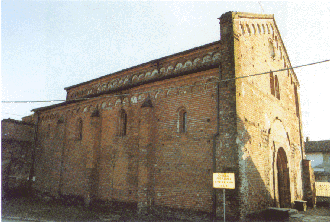
 St. Valerian’s church was part of an ancient Cluniac Priory, dating back to the 11th century. Its majesty highlights the important role it had along the Via Francigena. The monastery, along with all its facilities, was used by the Emperor and the Pope envoys as a free stopover to rest and pray. It was repeatedly plundered by different fighting armies.
St. Valerian’s church was part of an ancient Cluniac Priory, dating back to the 11th century. Its majesty highlights the important role it had along the Via Francigena. The monastery, along with all its facilities, was used by the Emperor and the Pope envoys as a free stopover to rest and pray. It was repeatedly plundered by different fighting armies.  Over the centuries the church too was sacked and destroyed, as the writing visible on the furthest pillar on the right-hand side proves. St. Valerian’s church follows the Latin cross design, with three naves. There is no trace left of the monastery, nor of the bell tower, still mentioned in documents from the 17th century. Decades later, under a non-religious management, St. Valerian’s church was split up into two separate floors and used as a storage room. There are not many frescos inside the church.
Over the centuries the church too was sacked and destroyed, as the writing visible on the furthest pillar on the right-hand side proves. St. Valerian’s church follows the Latin cross design, with three naves. There is no trace left of the monastery, nor of the bell tower, still mentioned in documents from the 17th century. Decades later, under a non-religious management, St. Valerian’s church was split up into two separate floors and used as a storage room. There are not many frescos inside the church.
Traduction by Elena Ferrara



